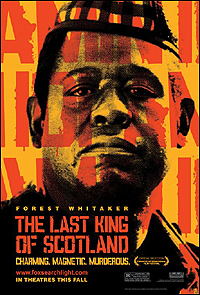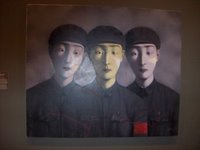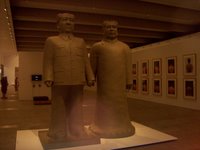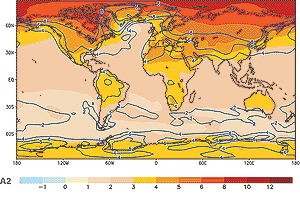 Across the world, St Valentine’s Day is taking place in many ways. Greenpeace are sending greetings to whalers, people in Manchester are getting over-the-counter Viagra, the DREF-AB worm is spamming email and so-called “valentine vinegars” are swapping anti-Valentine cards.
Across the world, St Valentine’s Day is taking place in many ways. Greenpeace are sending greetings to whalers, people in Manchester are getting over-the-counter Viagra, the DREF-AB worm is spamming email and so-called “valentine vinegars” are swapping anti-Valentine cards. And all this because of an ancient Roman festival. According to the legend, Rome was founded by the twins Romulus and Remus who were both suckled by a wolf. Although Rome needed the she-wolf to survive, the citizens were still afraid of wolves. The festival of Lupercalia was named for Lupercus 'the one who wards off the wolf'. The festival was also called “Februatio”. Lupercalia was a festival of purification. Each year on 15 February vestal virgins s brought sacred cakes made from the first ears of last year's grain harvest to the fig tree. Two naked young men, assisted by the Vestals, then sacrificed a dog and a goat at the site. The animal blood was smeared on the foreheads of the young men and then wiped away with wool dipped in milk.
Such a festival was deemed barbaric by Christian times. In 496 AD, Pope Gelasius summarily dismissed the festival of Lupercalia, calling it pagan and immoral. Casting the net around, he chose Valentine as the new patron saint of lovers, who would be honoured at the new festival a day earlier on the fourteenth of every February. In 270AD the Roman emperor Claudius II dragged the Empire into many wars and need a “surge” in troops. His solution was to ban marriage. One priest, a Valentine, disobeyed Claudius’s orders and married people anyway. He was imprisoned where he fell in love with the jailer’s daughter. On 14 February, 270 AD, Claudius had Valentine beheaded. Before walking to the gallows, Valentine wrote a farewell message to his love. He signed it, “From your Valentine.”
But we really don’t know much about the man who wrote the first Valentine message. At least three martyrs answered to that name in the early days of Christianity. He may have been may have been a bishop in the Umbrian city of Terni or a priest in Rome. Or he may even have lived and died in Africa. Of the three, the Terni bishop has the biggest claim.
 Both Ireland and Scotland have rival claims for Terni Valentine’s body. According to the Whitefriar Street Church in Dublin, an Irish Carmelite monk named John Sprat took Valentine’s remains back to Ireland in 1836. Meanwhile St Francis' Church, Glasgow claims to have received the bones in 1868 from a French family who collected religious relics.
Both Ireland and Scotland have rival claims for Terni Valentine’s body. According to the Whitefriar Street Church in Dublin, an Irish Carmelite monk named John Sprat took Valentine’s remains back to Ireland in 1836. Meanwhile St Francis' Church, Glasgow claims to have received the bones in 1868 from a French family who collected religious relics. In medieval times, people in England and France began to believe the middle of the second month was when birds first began to mate after the long winter. The coincidence with Valentine Day’s was picked up by William Chaucer. In his “Parliament of Foules” Chaucer wrote the second famous Valentine message
For this was sent on Seynt Valentyne's day
Whan every foul cometh ther to chese his make.
What Chaucer called chesing his make, we now call choosing his mate. Like the birds, humans have adapted Valentine’s Day as a signal of intent and love. So given its long history, it's not truly fair to call it a “hallmark holiday” though Valentine’s Day is now big business. Card and chocolate makers do well. The sale of flowers is second only to Mother’s day. Even in China where it was once seen as a symbol of the decadent west, Valentine’s Day is now a day to give extravagant presents such as watches, cruises, and limousine rides to dinner.
By contrast, the Chinese own version of Valentine’s Day is suffering. The festival is on the 7th day of the 7th lunar month in the Chinese calendar (which usually falls in August). The date is based on the legend of the 7th daughter of Emperor of Heaven who fell in love with an orphaned cowherd. They were separated by their own valentine vinegar, the Emperor of Heaven himself who banished his daughter to the star Vega and the cowherd to the star Altair. The 7th day of the 7th month is the only time the two are allowed to be together. For this reason, the festival is also called the Daughter’s Festival.
Meanwhile the Japanese have broken up their love festival into two separate days. On 14 February, only the women give presents and exactly a month later it’s the men’s turn on a so-called “White Day”. The concept is called “giri” and it’s not strictly romantic. Giri is a mutual obligation that is taken very seriously and people bestow their gift (usually chocolate) to bosses, colleagues or friends not necessarily out of love interest, but just for friendship, gratitude or the returning of a favour.
 Not everything about 14 February is related to love. In 1929 on that date Chicago exploded to the sound of the Valentine Day’s massacre. Seven of George “Bugs” Moran’s men were shot dead when they were told to meet at a warehouse. Moran himself suspected something fishy was happening and escaped leaving his men to die. He blamed Al Capone for the hit saying “Only Capone kills guys like that”. Capone got away with that but was eventually done for tax evasion. After spending almost 5 years in Alcatraz he died at home, three weeks before Valentine Day, 1947 from complications of syphilis.
Not everything about 14 February is related to love. In 1929 on that date Chicago exploded to the sound of the Valentine Day’s massacre. Seven of George “Bugs” Moran’s men were shot dead when they were told to meet at a warehouse. Moran himself suspected something fishy was happening and escaped leaving his men to die. He blamed Al Capone for the hit saying “Only Capone kills guys like that”. Capone got away with that but was eventually done for tax evasion. After spending almost 5 years in Alcatraz he died at home, three weeks before Valentine Day, 1947 from complications of syphilis. Happy lupercalia.


























